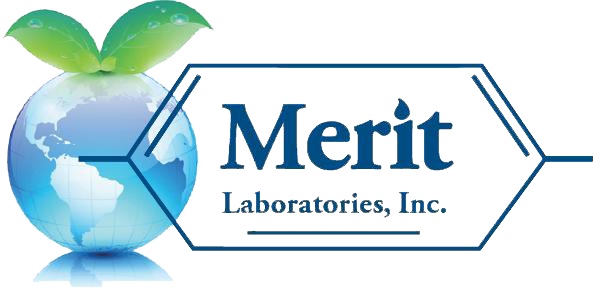Merit Laboratories offers several analytical options for PFAS. Analytical methods performed by Merit Laboratories include EPA 533, EPA 537 Rev. 1.1, EPA 537.1 ASTM D7979-19 with Isotopic Dilution, and ASTM D7968-17. The following summary will help guide you through selecting the most appropriate PFAS method for your project.
EPA 537 Rev. 1.1: This is a drinking water method for 14 PFAS compounds using Solid Phase Extraction and Liquid Chromatography/Tandem Mass Spectrometry (LC/MS/MS). As with most EPA drinking water methods, EPA 537 is prescriptive and the only allowable modifications are mentioned in the method. The U.S. EPA has made it abundantly clear that EPA 537 should not be used for any sample matrix other than drinking water. Additionally, the method is limited to the 14 PFAS compounds listed in the method. Merit performs EPA 537 rev. 1.1 in drinking water for the list of 14 compounds.
EPA 537.1: A drinking water method updated in 2020. EPA 537.1, a prescriptive method, is performed for the determination of a select list of 18 PFAS compounds using Solid Phase Extraction and Liquid Chromatography/Tandem Mass Spectrometry (LC/MS/MS). This revision is an update to EPA 537, first published in 2009. Merit performs EPA 537.1 in drinking water for the list of 18 compounds detailed in the method.
PFAS by LC/MS/MS Compliant with QSM Table B-15 (DoD Method): A replacement for Method 537M. The PFAS method listed in the Department of Defense Quality Systems Manual. This method is appropriate for Department of Defense projects or other projects requiring DoD ELAP accreditation.
ASTM D7979-19 with Isotopic Dilution: A method that was approved and published by ASTM D19 for non-drinking water samples. It is the first validated method for non-drinking water aqueous matrices for PFCs using Liquid Chromatography/Tandem Mass Spectrometry (LC/MS/MS). EPA Region 5 Laboratory completed development of ASTM D7979. During our method development for ASTM D7979, Merit was able to consistently demonstrate much better recoveries for all PFAS compounds. The better recoveries are partly attributed to much less sample handling. Sample handling can both contaminate and remove compounds of interest in your samples. There are other key advantages for using ASTM D7979 with Isotopic Dilution. One such advantage is there is much less chance of contamination or analyte loss. ASTM D7979 also provides consistent results. It should be noted that in order to achieve low limits of detection, the laboratory must commit to using the latest state-of-art instrumentation and technology and employing much longer run times to separate out interferences. The ASTM method is simpler to prep samples, however, that is where the simplicity ends. When running samples using SPE you gain two significant advantages: (1) 250 times multiplier, which allows for lower detection limit; and, (2) Removal of many interferences. By using these two advantages, a laboratory can significantly shorten the run time, while the effect of multiplications allows for the use of less-sensitive instrumentation.
ASTM D7968-17 with Isotopic Dilution: A PFAS method performed for soil and solid matrices. Developed by the U.S. EPA Region 5 Chicago Regional Laboratory (CRL), this method is performed using Liquid Chromatography/Tandem Mass Spectrometry (LC/MS/MS). Merit performs ASTM D7968-17 to support site investigation efforts or other projects involving the collection of soil or solid samples. Soil samples are prepared for analysis with a solvent extraction prior to analysis.
EPA 533: A new drinking water method for short chain PFAS (none greater than C12). This method includes a total of 25 PFAS compounds, which includes 14 of the 18 listed in EPA 537.1 along with 11 additional short chain PFAS. The list of additional compounds in EPA 533 includes those that cannot be analyzed by EPA 537.1 because of physicochemical properties. EPA 533 is performed by Isotope Dilution Anion Exchange Solid Phase Extraction and Liquid Chromatography/Tandem Mass Spectrometry. Isotope dilution is incorporated into the method, which can minimize sample matrix interference and improve data quality.
EPA 8327: A new validated method for PFAS using external standard calibration and Multiple Reaction Monitoring (MRM) Liquid Chromatography/Tandem Mass Spectrometry (LC/MS/MS). The method is for non-drinking water aqueous samples, including groundwater, surface water, and wastewater. EPA 8327 is similar to ASTM D7979-19 minus the isotopic dilution. There are 24 PFAS compounds listed in the EPA 8327.
Merit is a leading national PFAS environmental laboratory, analyzing drinking water, soil, wastewater, groundwater, and other sample matrices, including biosolids and sludge. Analytical methods performed by Merit for PFAS include drinking water by EPA 533, EPA 537.1, and EPA 537 rev. 1.1 and soil, wastewater, groundwater, and surface water by ASTM D7979-19 with Isotopic Dilution and ASTM D7968-17.

